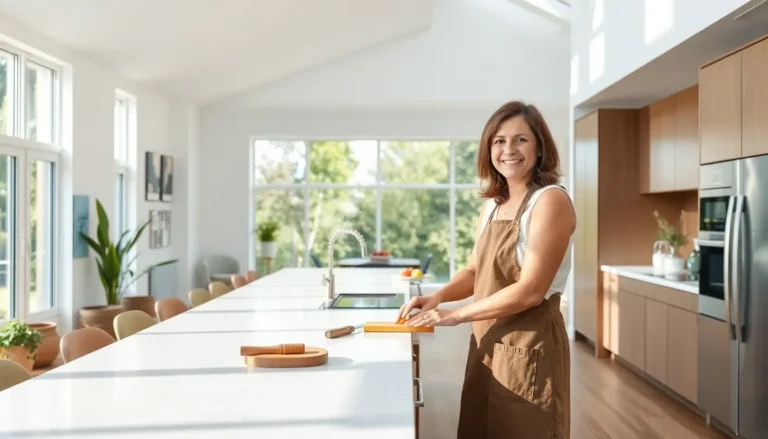Home is where the heart is, but let’s be real—it’s also where the occasional trip hazard lurks and that pesky smoke detector is just waiting for a battery change. Conducting a home safety audit might sound as thrilling as watching paint dry, but it’s the ultimate way to keep your castle safe from sneaky accidents.
Table of Contents
ToggleWhat Is a Home Safety Audit?
A home safety audit is a comprehensive assessment of a residence aimed at identifying potential hazards. This evaluation focuses on various aspects, including fire safety, security measures, and health risks. Conducting an audit encourages homeowners to take proactive steps toward a safer living environment.
Fire safety plays a critical role in the audit process. Checking smoke detectors, ensuring fire extinguishers are accessible, and maintaining clear escape routes significantly reduce fire hazards. Additionally, verifying that all electrical outlets and appliances meet safety standards can prevent electrical fires.
Security measures are another vital component. Homeowners assess locks on doors and windows, ensuring they function properly. Installing motion-activated lights around the perimeter also enhances safety.
Health risks associated with indoor air quality deserve attention. Inspecting for mold or asbestos, as well as ensuring proper ventilation, contributes to a healthier living space. Furthermore, checking carbon monoxide detectors protects residents from this odorless gas.
Finally, evaluating outdoor areas completes the audit. A thorough inspection of the yard for potential tripping hazards, unstable structures, and adequate lighting enhances safety. Homeowners can minimize risks by keeping pathways clear and ensuring that outdoor furniture is secure.
Overall, a home safety audit identifies various risks and facilitates the implementation of necessary safety measures. Completing this process helps maintain a safe environment, protects residents, and fosters peace of mind.
Importance of Conducting a Home Safety Audit

Conducting a home safety audit significantly enhances a household’s overall safety. It pinpoints risks and allows residents to create a secure environment.
Identifying Potential Hazards
Potential hazards can lurk in various forms throughout a home. Checking smoke detectors ensures they function correctly, while accessible fire extinguishers prepare homeowners for emergencies. Electrical outlets should meet safety standards to minimize fire hazards. Mold and asbestos inspections contribute to indoor air quality, promoting health for residents. Additionally, evaluating outdoor spaces helps identify tripping hazards and other risks to physical safety.
Enhancing Family Security
Family security benefits from a thorough home safety audit as well. Assessing locks on doors and windows reinforces protection against intruders. Installing motion-activated lights deters unwanted access and increases visibility at night. Additionally, evaluating outdoor areas for proper lighting aids in preventing accidents and enhances security measures. The combination of reliable locks, effective lighting, and routine checks ensures that families feel secure in their homes.
Steps to Perform a Home Safety Audit
A home safety audit involves several critical steps for ensuring a safe environment. Proper preparation followed by thorough assessment can pinpoint potential hazards effectively.
Preparing for the Audit
Preparation forms the foundation of a successful audit. Gather essential materials such as a checklist, a flashlight, and tools for minor fixes. Allocate sufficient time for the process, as thoroughness matters. Engaging all household members in the audit fosters awareness and encourages collaboration. Establish a clear plan on which areas to address first, ensuring nothing is overlooked during the assessment.
Assessing Each Area of Your Home
Assessment requires a systematic approach across each area. Begin in the living room, checking smoke detectors, fire extinguishers, and electrical outlets. Next, review bedrooms for clutter and ensure escape routes are accessible. Examine kitchens for fire hazards, verifying that appliances are in good condition and properly stored. Bathrooms require checks for slip risks and the presence of mold. Outdoor areas should also be included by inspecting pathways for tripping hazards and ensuring adequate lighting. Each area of the home plays a role in overall safety; addressing concerns promptly is essential.
Common Areas to Evaluate
Conducting a thorough evaluation of common areas is vital for ensuring home safety. Each space presents unique risks that require careful consideration.
Kitchen Safety
Kitchen safety focuses on preventing accidents that can occur during food preparation. Check appliances for frayed cords and ensure they are positioned away from water to reduce electrical hazards. Store knives and sharp utensils in safe locations, preventing accidental cuts. Furthermore, maintain a clean area to avoid slips and falls from spills. Ensure smoke detectors are functional and positioned properly, as kitchen fires create serious risks.
Living Room and Bedroom Safety
Living rooms and bedrooms demand attention for fire and security risks. Secure heavy furniture against walls to prevent tipping. Ensure electrical outlets are not overloaded, minimizing fire hazards. Keep pathways clear of clutter to reduce tripping hazards. Install smoke detectors and test them monthly for functionality. Use door and window locks to enhance security, deterring unwanted intruders.
Bathroom Safety
Bathroom safety requires attention to slip-proofing and accessibility. Use non-slip mats in and around bathtubs or showers to prevent slips. Install grab bars near toilets and in showers, providing extra support. Ensure bathroom lighting is bright enough for visibility, particularly at night. Keep all medications and cleaning products stored out of reach of children for health safety.
Outdoor Safety
Outdoor areas present unique risks that warrant thorough evaluation. Inspect walkways and driveways for cracks or uneven surfaces, which can lead to falls. Maintain lighting around entryways to enhance visibility after dark. Secure outdoor furniture and tools to prevent them from becoming hazards during storms. Evaluate fencing for any gaps that may allow pets or children to wander off, ensuring a secure yard.
Tips for Effective Home Safety Audits
Start by creating a detailed checklist that covers all areas of the home. Include items like smoke detectors, fire extinguishers, and electrical outlets. Gather essential tools, such as a flashlight and basic repairs kit, before beginning the audit. Involve all household members in the process for diverse perspectives on safety.
Assess each room systematically, beginning with common areas like the living room. Check for clear pathways to reduce tripping hazards and secure heavy furniture to prevent tipping. Bedrooms should feature accessible emergency exits and adequate lighting.
Focus on kitchen safety to prevent accidents during meal preparation. Make sure appliances function correctly and store sharp objects out of reach. Clean surfaces regularly to avoid slips and spills.
Bathroom evaluations require specific attention to slip-proofing measures. Install non-slip mats and consider adding grab bars for stability. Ensure that all items, including toiletries, are within easy reach for all family members.
Outdoor spaces also demand inspection. Walkways should be free of debris, and adequate lighting will enhance security at night. Check the condition of fences to secure the property effectively.
Evaluate each area for potential health risks. Inspect for mold and ensure ventilation is adequate. This audit not only highlights safety concerns but also enables homeowners to make informed decisions about necessary changes. Prioritizing these features contributes directly to the well-being of residents.
A home safety audit is an essential step toward creating a secure living environment. By identifying potential hazards and addressing them proactively, homeowners can significantly reduce the risk of accidents. This process not only enhances physical safety but also promotes peace of mind for all residents. Engaging the entire household in the audit fosters a collective responsibility for safety and encourages awareness of potential risks. Regularly conducting these audits ensures that homes remain safe and secure, adapting to any changes in the living environment. Investing time in a thorough safety assessment is a small effort that can lead to substantial benefits for everyone in the home.



